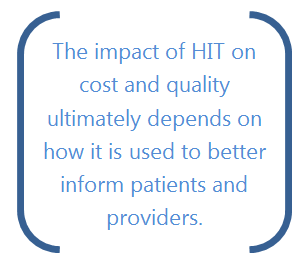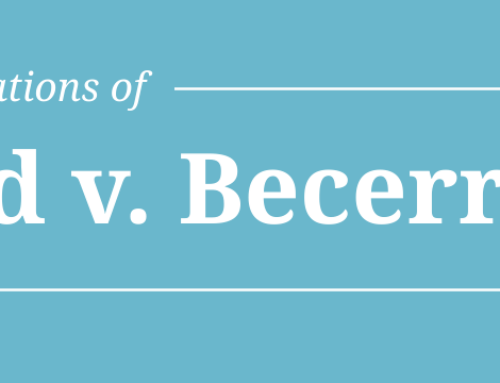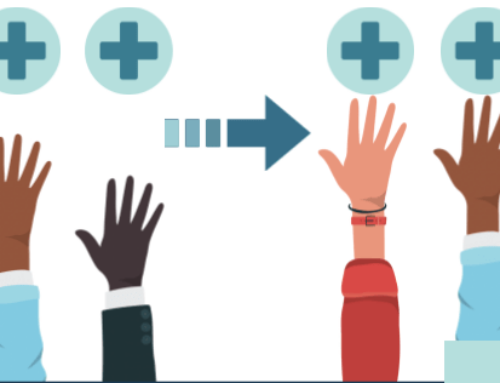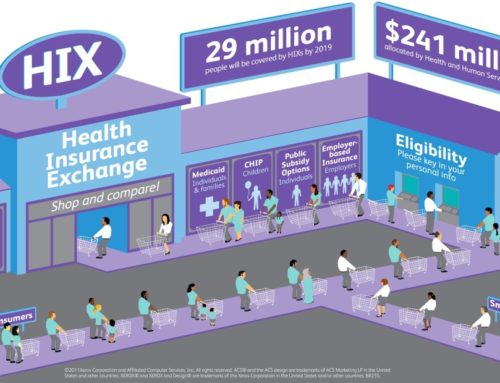Health Information Technology & V-BID: A Synergistic Combination Introduction
Value-Based Insurance Design (V-BID) is an innovative approach that can improve clinical outcomes and contain costs. The basic premise of V-BID is to align consumer incentives with value by reducing barriers to high-value health services and providers (‘carrots’) and discouraging the use of low-value health services and providers (‘sticks’). When ‘carrots’ are coupled with ‘sticks’ in a clinically nuanced manner, V-BID improves health care quality and controls spending growth. The concept of clinical nuance recognizes that: 1) medical services differ in the benefit provided; and 2) the clinical benefit derived from a specific service depends on the patient using it. This brief examines how the incorporation of V-BID principles into health information technology (HIT) can enhance the potential for HIT to improve quality and increase efficiency.
Interoperable HIT systems, meaning systems with the capability to “talk to each other” by exchanging information and integrating incoming data, have an immense potential to produce better health, improve safety, enhance consumers’ care experience, and lower costs. The widespread adoption and use of HIT can better ensure that consumers receive not only the right care, but in the right venue, and at the right time. Additionally, decision support tools and mobile applications can augment the timeliness and extend the reach of care delivery. For example, as smartphones are converted to glucometers and home scales wirelessly transmit an individual’s body weight to their clinician in real time, it becomes easier for individuals with diabetes or congestive heart failure to track quality metrics and share data with their providers. Moreover, as clinical recommendations produced by sophisticated HIT tools are gradually linked to evidence-based incentives for consumers [through benefit design] and providers [through payment mechanisms], the likelihood of HIT delivering on its immense potential is amplified.
Ways HIT Systems Can Integrate “Clinical Nuance”:
- Adapting care to the individual patient in the appropriate clinical situation. As integrated systems gather additional data from patients and provide a more complete medical history at the point of care, providers will have more information regarding the services that are the most beneficial for specific patient groups and for specific clinical scenarios. Coupling these systems with evidence-based decision support tools will assist providers in determining the value of services for individuals based on their clinical history. Integrating this clinical support information into innovative payment models (e.g., Pay for Performance) and benefit designs (e.g., V-BID) that provide incentives for clinicians and individuals to use high-value care and discourage low-value services is an important extension to most existing HIT models.
- Arming patients with more personalized information. Providers’ HIT systems, when combined with patient-facing mobile and web-based applications, will make it easier for consumers to utilize tools that can educate about the various treatments available and the pros and cons of each option. HIT applications can make it easier for enrollees in V-BID plans to participate in shared decision-making programs which would ultimately increase the possibility for those individuals to receive appropriate care.
- Deploying clinically nuanced ‘carrots’ and ‘sticks’ more effectively. Robust data from integrated HIT systems could target incentives and disincentives to the most appropriate patients on the basis of medical history and clinical situation, making it more likely that carrots and sticks are deployed where they will generate the most value. Better data from HIT would also make it more straightforward to appropriately exempt certain enrollees from disincentives on the basis of specific clinical circumstances in a more consistent, fair, and effective manner.
- Identifying high-value providers and settings. Value in care delivery is often determined by who provides the service [e.g. specialist vs. primary care] and where it is provided [e.g. ambulatory care center vs. hospital]. HIT systems can facilitate a more sophisticated and accurate view with respect to identifying high value providers, such as those practicing in a qualified patient-centered medical home or center of excellence. Data collection and analytic capabilities allow the differentiation of providers on quality measures and resource use which can inform the creation and implementation of tiered networks and consumer incentive programs that steer patients to preferred providers.
- Understanding intermediate outcomes of a transforming delivery system. HIT systems could make it more feasible to rapidly measure improvements in key intermediate outcomes such as laboratory values or medication adherence that occur in response to the implementation of new care delivery models, innovative payment programs, and consumer engagement initiatives. This ability to quickly and accurately assess short-term clinical and economic impact would be a welcome addition to current systems where data analysis is often cumbersome and time-consuming.
To illustrate the potential synergies between clinically nuanced decision support and a V-BID program, consider the following example:
A 70-year old woman with diabetes presents to her primary care physician’s clinic for a routine visit. While checking in, the IT system confirms her diabetes diagnosis and informs the clinician that she has not had a recent diabetic eye exam and recommends that the exam be scheduled. The system also recognizes that she had an HgA1c test last week as part of her home health program, so there is no need to duplicate the test during that visit. The system also informs the clinician that she is enrolled in a V-BID health plan that eliminates the patient’s copayment for guideline-recommended diabetes care, such as medications, HgA1c tests and eye exams. The woman is very appreciative, because she did not want to get another blood test and had forgotten that her annual eye exam was fully covered by her health plan.
 This simple example plainly illustrates the immense opportunity for HIT to support the transition to a clinically-driven, cost-effective healthcare system. By encouraging consumers and their providers to use more recommended, evidence-based services and discouraging the use of low value services, HIT could improve quality of care, while assisting in eliminating the time and cost involved in unnecessary tests and procedures. In addition, published evidence suggests that when barriers are lowered for high value care, their use will significantly increase. The clear synergies between HIT and payment/benefit reform are underappreciated and should be considered as part of an integrated, coordinated delivery system.
This simple example plainly illustrates the immense opportunity for HIT to support the transition to a clinically-driven, cost-effective healthcare system. By encouraging consumers and their providers to use more recommended, evidence-based services and discouraging the use of low value services, HIT could improve quality of care, while assisting in eliminating the time and cost involved in unnecessary tests and procedures. In addition, published evidence suggests that when barriers are lowered for high value care, their use will significantly increase. The clear synergies between HIT and payment/benefit reform are underappreciated and should be considered as part of an integrated, coordinated delivery system.
Conclusion
Well-designed, interoperable HIT systems are rapidly becoming an integral part of the changing US healthcare landscape. Nevertheless, it is crucial to recognize that HIT is merely a tool; the impact of HIT on cost and quality ultimately depends on how it is used to better inform patients and providers. When deployed in a clinically-driven fashion, payers and consumers can be more confident that they will receive the care they need, by the right provider and in the optimal setting. From a system standpoint, HIT built on the concept of clinical nuance will help guarantee that resources will be allocated with both clinical outcomes and financial considerations in mind. As these systems become better integrated with payment reform and consumer engagement initiatives, more health can be achieved for every dollar spent.






